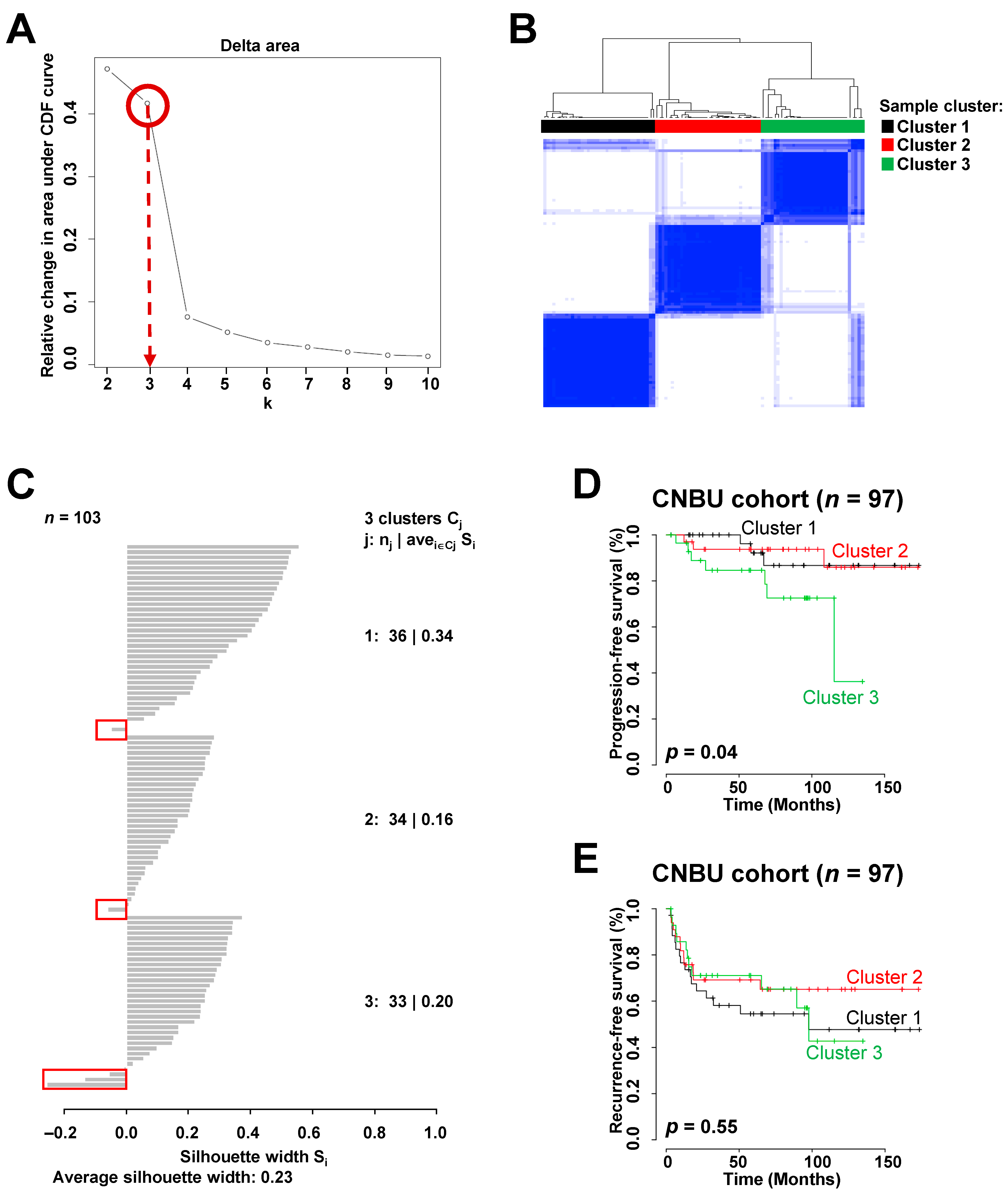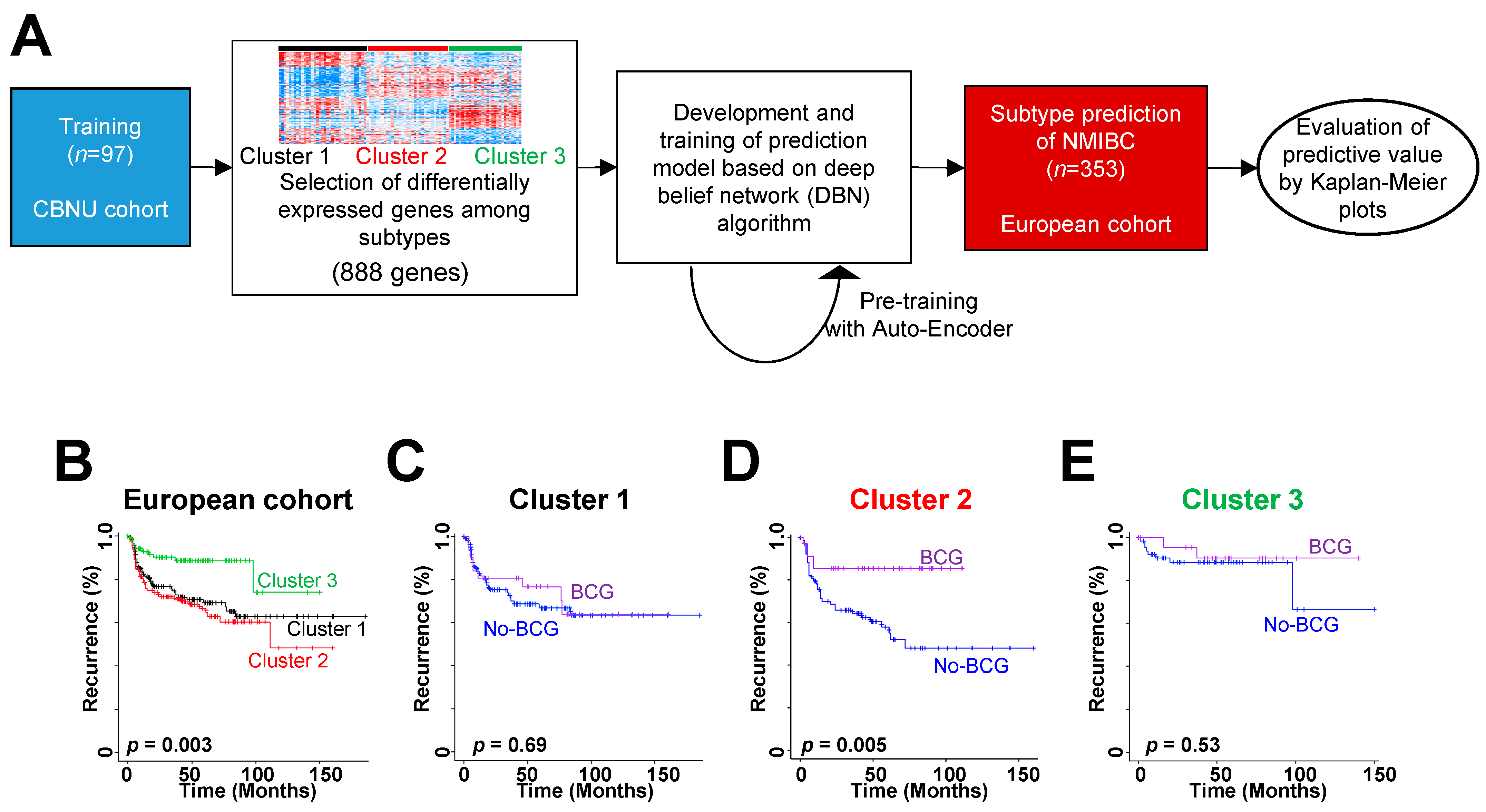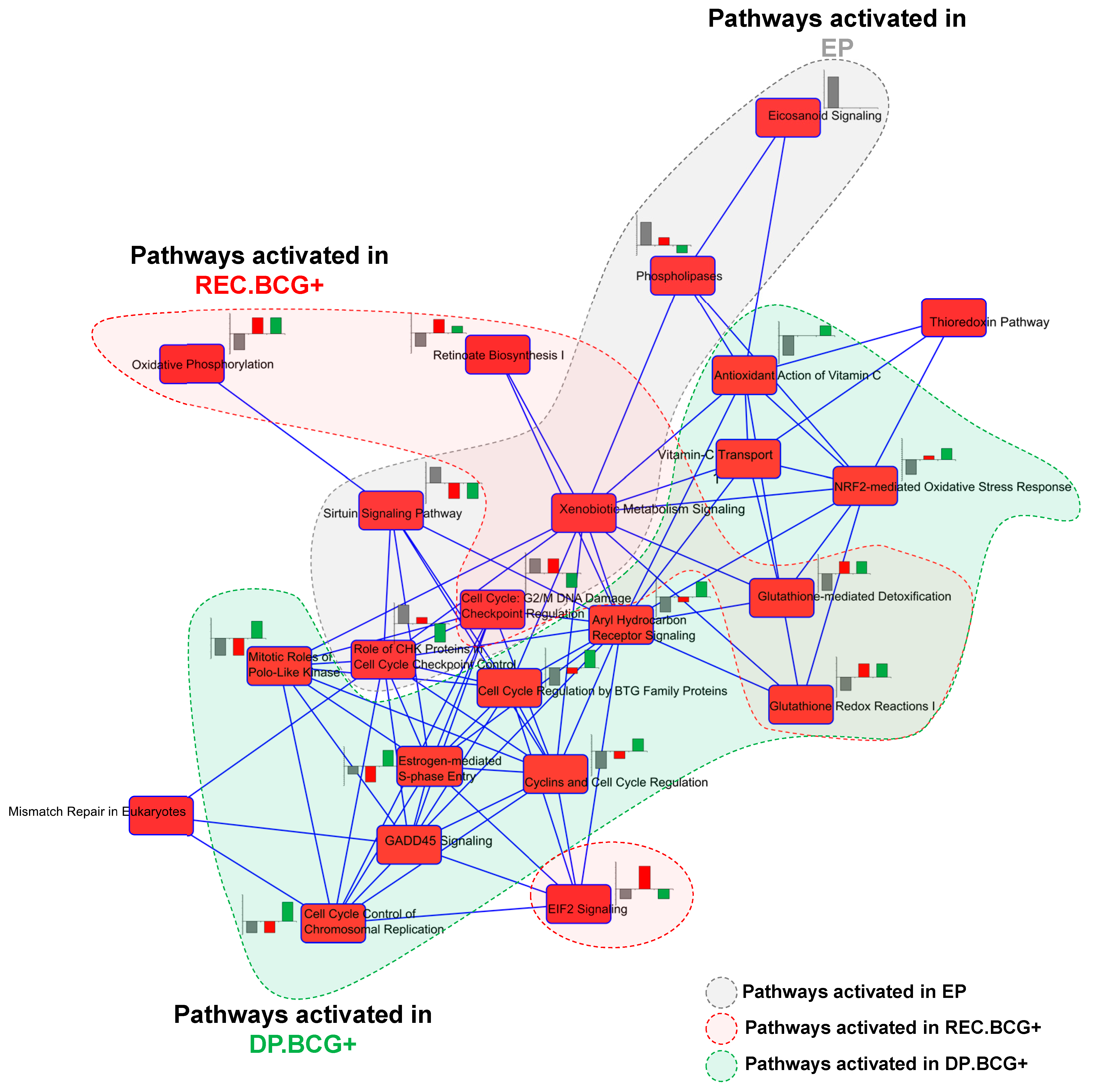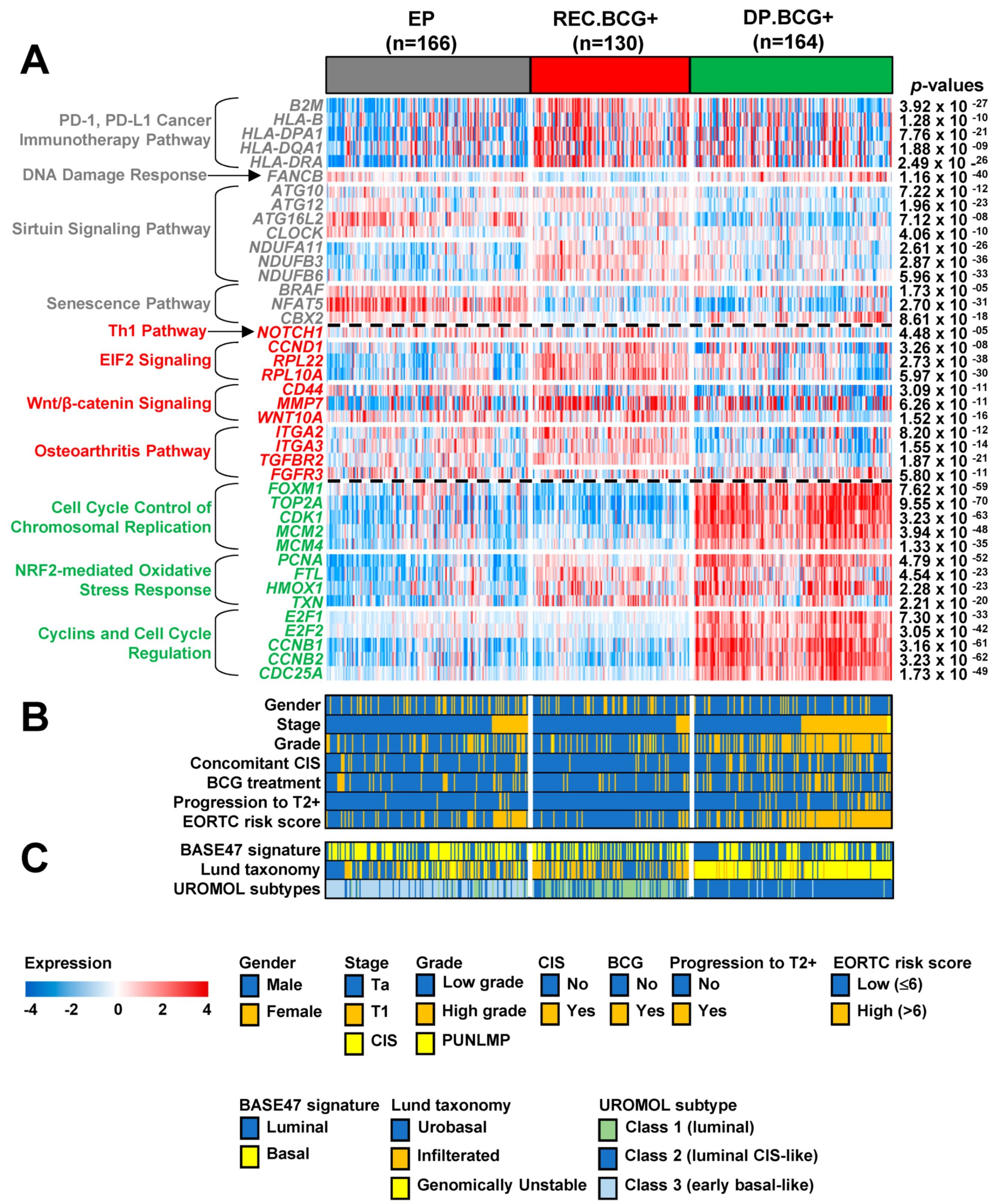A Molecular Signature Determines the Prognostic and Therapeutic Subtype of Non-Muscle-Invasive Bladder Cancer Responsive to Intravesical Bacillus Calmette-Guérin Therapy
Abstract
1. Introduction
2. Results
2.1. Establishment of Distinct Molecular Subtypes Associated with Prognosis of NMIBC
2.2. One Subtype, Cluster 3, Is Predictive of Disease Progression and a Better Response to BCG Treatment
2.3. One Subtype, Cluster 2, Is Associated with Disease Recurrence and a Better Response to BCG Treatment
2.4. Validation of Prognostic Subtypes in an Independent Cohort
2.5. Biologic Characteristics of the Molecular Subtypes of NMIBC
2.6. Comparison of Previously Known Molecular Subtypes with the MSP888 Predictor of NMIBC
3. Discussion
4. Materials and Methods
4.1. Public Datasets of NMIBC Patients
4.2. Patients and Tissue Samples of a Validation Cohort
4.3. RNA Extraction, RNAseq Experiments, and Data Processing
4.4. Transcriptomic Profiling
4.5. Development of a Signature-Based Classifer
4.6. Function Enrichment Analysis
4.7. Other Statistical Analysis
4.8. Data Availability
Supplementary Materials
Author Contributions
Funding
Institutional Review Board Statement
Informed Consent Statement
Data Availability Statement
Conflicts of Interest
References
- Ferlay, J.; Soerjomataram, I.; Dikshit, R.; Eser, S.; Mathers, C.; Rebelo, M.; Parkin, D.M.; Forman, D.; Bray, F. Cancer incidence and mortality worldwide: Sources, methods and major patterns in GLOBOCAN 2012. Int. J. Cancer 2015, 136, E359–E386. [Google Scholar] [CrossRef] [PubMed]
- Babjuk, M.; Bohle, A.; Burger, M.; Capoun, O.; Cohen, D.; Comperat, E.M.; Hernandez, V.; Kaasinen, E.; Palou, J.; Roupret, M.; et al. EAU guidelines on non-muscle-invasive urothelial carcinoma of the bladder: Update 2016. Eur. Urol. 2017, 71, 447–461. [Google Scholar] [CrossRef] [PubMed]
- Schmidt, S.; Kunath, F.; Coles, B.; Draeger, D.L.; Krabbe, L.M.; Dersch, R.; Kilian, S.; Jensen, K.; Dahm, P.; Meerpohl, J.J. Intravesical Bacillus Calmette-Guerin versus mitomycin C for Ta and T1 bladder cancer: Abridged summary of the Cochrane Review. Investig Clin. Urol. 2020, 61, 349–354. [Google Scholar] [CrossRef] [PubMed]
- Jordan, B.; Meeks, J.J. T1 bladder cancer: Current considerations for diagnosis and management. Nat. Rev. Urol. 2019, 16, 23–34. [Google Scholar] [CrossRef]
- Gual Frau, J.; Palou, J.; Rodriguez, O.; Parada, R.; Breda, A.; Villavicencio, H. Failure of Bacillus Calmette-Guerin therapy in non-muscle-invasive bladder cancer: Definition and treatment options. Arch. Esp. Urol. 2016, 69, 423–433. [Google Scholar]
- Yun, S.J.; Kim, S.K.; Kim, W.J. How do we manage high-grade T1 bladder cancer? Conservative or aggressive therapy? Investig. Clin. Urol. 2016, 57, S44–S51. [Google Scholar] [CrossRef]
- Hedegaard, J.; Lamy, P.; Nordentoft, I.; Algaba, F.; Hoyer, S.; Ulhoi, B.P.; Vang, S.; Reinert, T.; Hermann, G.G.; Mogensen, K.; et al. Comprehensive Transcriptional Analysis of Early-Stage Urothelial Carcinoma. Cancer Cell 2016, 30, 27–42. [Google Scholar] [CrossRef]
- Robertson, A.G.; Groeneveld, C.S.; Jordan, B.; Lin, X.; McLaughlin, K.A.; Das, A.; Fall, L.A.; Fantini, D.; Taxter, T.J.; Mogil, L.S.; et al. Identification of Differential Tumor Subtypes of T1 Bladder Cancer. Eur. Urol. 2020, 78, 533–537. [Google Scholar] [CrossRef]
- Kim, S.K.; Roh, Y.G.; Park, K.; Kang, T.H.; Kim, W.J.; Lee, J.S.; Leem, S.H.; Chu, I.S. Expression signature defined by FOXM1-CCNB1 activation predicts disease recurrence in non-muscle-invasive bladder cancer. Clin. Cancer Res. 2014, 20, 3233–3243. [Google Scholar] [CrossRef]
- Mun, J.Y.; Baek, S.W.; Park, W.Y.; Kim, W.T.; Kim, S.K.; Roh, Y.G.; Jeong, M.S.; Yang, G.E.; Lee, J.H.; Chung, J.W.; et al. E2F1 Promotes Progression of Bladder Cancer by Modulating RAD54L Involved in Homologous Recombination Repair. Int. J. Mol. Sci. 2020, 23, 9025. [Google Scholar] [CrossRef]
- Roh, Y.G.; Mun, J.Y.; Kim, S.K.; Park, W.; Jeong, M.S.; Kim, T.N.; Kim, W.T.; Choi, Y.H.; Chu, I.S.; Leem, S.H. Fanconi Anemia Pathway Activation by FOXM1 Is Critical to Bladder Cancer Recurrence and Anticancer Drug Resistance. Cancers 2020, 6, 1417. [Google Scholar] [CrossRef] [PubMed]
- Biton, A.; Bernard-Pierrot, I.; Lou, Y.; Krucker, C.; Chapeaublanc, E.; Rubio-Perez, C.; Lopez-Bigas, N.; Kamoun, A.; Neuzillet, Y.; Gestraud, P.; et al. Independent component analysis uncovers the landscape of the bladder tumor transcriptome and reveals insights into luminal and basal subtypes. Cell Rep. 2014, 9, 1235–1245. [Google Scholar] [CrossRef] [PubMed]
- Damrauer, J.S.; Hoadley, K.A.; Chism, D.D.; Fan, C.; Tiganelli, C.J.; Wobker, S.E.; Yeh, J.J.; Milowsky, M.I.; Iyer, G.; Parker, J.S.; et al. Intrinsic subtypes of high-grade bladder cancer reflect the hallmarks of breast cancer biology. Proc. Natl. Acad. Sci. USA 2014, 111, 3110–3115. [Google Scholar] [CrossRef] [PubMed]
- Choi, W.; Czerniak, B.; Ochoa, A.; Su, X.; Siefker-Radtke, A.; Dinney, C.; McConkey, D.J. Intrinsic basal and luminal subtypes of muscle-invasive bladder cancer. Nat. Rev. Urol. 2014, 11, 400–410. [Google Scholar] [CrossRef]
- Sjodahl, G.; Lauss, M.; Lovgren, K.; Chebil, G.; Gudjonsson, S.; Veerla, S.; Patschan, O.; Aine, M.; Ferno, M.; Ringner, M.; et al. A molecular taxonomy for urothelial carcinoma. Clin. Cancer Res. 2012, 18, 3377–3386. [Google Scholar] [CrossRef] [PubMed]
- Wilkerson, M.D.; Hayes, D.N. ConsensusClusterPlus: A class discovery tool with confidence assessments and item tracking. Bioinformatics 2010, 26, 1572–1573. [Google Scholar] [CrossRef] [PubMed]
- Hinton, G.E.; Osindero, S.; Teh, Y.W. A fast learning algorithm for deep belief nets. Neural Comput. 2006, 18, 1527–1554. [Google Scholar] [CrossRef]
- Langle, Y.V.; Belgorosky, D.; Prack McCormick, B.; Sahores, A.; Gongora, A.; Baldi, A.; Lanari, C.; Lamb, C.; Eijan, A.M. FGFR3 Down-Regulation is Involved in bacillus Calmette-Guerin Induced Bladder Tumor Growth Inhibition. J. Urol. 2016, 195, 188–197. [Google Scholar] [CrossRef]
- Piao, X.M.; Byun, Y.J.; Kim, W.J.; Kim, J. Unmasking molecular profiles of bladder cancer. Investig. Clin. Urol. 2018, 59, 72–82. [Google Scholar] [CrossRef]
- Song, B.N.; Kim, S.K.; Mun, J.Y.; Choi, Y.D.; Leem, S.H.; Chu, I.S. Identification of an immunotherapy-responsive molecular subtype of bladder cancer. EBioMedicine 2019, 50, 238–245. [Google Scholar] [CrossRef]
- Kim, S.K.; Ahn, S.G.; Mun, J.Y.; Jeong, M.S.; Bae, S.J.; Lee, J.S.; Jeong, J.; Leem, S.H.; Chu, I.S. Genomic Signature of the Standardized Uptake Value in (18)F-Fluorodeoxyglucose Positron Emission Tomography in Breast Cancer. Cancers 2020, 2, 497. [Google Scholar] [CrossRef]
- Cui, J.; Shi, M.; Xie, D.; Wei, D.; Jia, Z.; Zheng, S.; Gao, Y.; Huang, S.; Xie, K. FOXM1 promotes the warburg effect and pancreatic cancer progression via transactivation of LDHA expression. Clin. Cancer Res. 2014, 20, 2595–2606. [Google Scholar] [CrossRef] [PubMed]
- Kim, W.J.; Kim, E.J.; Kim, S.K.; Kim, Y.J.; Ha, Y.S.; Jeong, P.; Kim, M.J.; Yun, S.J.; Lee, K.M.; Moon, S.K.; et al. Predictive value of progression-related gene classifier in primary non-muscle invasive bladder cancer. Mol. Cancer 2010, 9, 3. [Google Scholar] [CrossRef] [PubMed]
- Dyrskjot, L.; Zieger, K.; Real, F.X.; Malats, N.; Carrato, A.; Hurst, C.; Kotwal, S.; Knowles, M.; Malmstrom, P.U.; de la Torre, M.; et al. Gene expression signatures predict outcome in non-muscle-invasive bladder carcinoma: A multicenter validation study. Clin. Cancer Res. 2007, 13, 3545–3551. [Google Scholar] [CrossRef] [PubMed]
- Malmstrom, P.U.; Sylvester, R.J.; Crawford, D.E.; Friedrich, M.; Krege, S.; Rintala, E.; Solsona, E.; Di Stasi, S.M.; Witjes, J.A. An individual patient data meta-analysis of the long-term outcome of randomised studies comparing intravesical mitomycin C versus bacillus Calmette-Guerin for non-muscle-invasive bladder cancer. Eur. Urol. 2009, 56, 247–256. [Google Scholar] [CrossRef]





| Variable | Univariate | Multivariate | |||
|---|---|---|---|---|---|
| HR (95% CI) | p-Value | HR (95% CI) | p-Value | ||
| Disease progression in the UROMOL cohort | Gender | ||||
| male (Ref.) vs. female | 1.219 (0.545–2.725) | 0.63 | |||
| Age | |||||
| ≤65 (Ref.) vs. >65 | 1.946 (0.838–4.52) | 0.121 | |||
| Stage | |||||
| Ta | Ref. | Ref. | |||
| T1 | 9.138 (4.202–19.873) | <0.0001 # | 7.437 (3.286–16.831) | <0.0001 # | |
| CIS | 0.000 (0.000–4.47E + 276) | 0.978 | 0.000 (0.000–2.121E + 298) | 0.979 | |
| Grade | |||||
| PUNLMP | Ref. | ||||
| Low | 1829.893 (0.000–8.723E + 83) | 0.937 | |||
| High | 7927.856 (0.000–3.777E + 84) | 0.925 | |||
| Tumor size | |||||
| <3 cm | Ref. | ||||
| ≥3 cm | 1.723 (0.754–3.936) | 0.197 | |||
| unknown | 0.599 (0.204–1.760) | 0.351 | |||
| Subtypes * | |||||
| Clusters 1 and 2 (Ref.) vs. 3 * | 5.899 (2.635–13.204) | <0.0001 # | 3.447 (1.483–8.012) | 0.004 # | |
| Disease recurrence in the European cohort | Gender | ||||
| male (Ref.) vs. female | 1.063 (0.594–1.901) | 0.838 | |||
| Age | |||||
| ≤65 (Ref.) vs. > 65 | 0.904 (0.571–1.431) | 0.666 | |||
| Stage | |||||
| Ta | Ref. | Ref. | |||
| T1 | 24.372 (7.673–77.417) | <0.0001 # | 21.090 (6.613–67.262) | <0.0001 # | |
| CIS | 36.658 (6.103–220.177) | <0.0001 # | 69.542 (10.365–466.567) | <0.0001 # | |
| Grade | |||||
| PUNLMP | Ref. | ||||
| Low | 0.371 (0.183–0.752) | 0.006 # | |||
| High | 1.390 (0.709–2.724) | 0.338 | |||
| Subtypes * | |||||
| Clusters 1 and 2 (Ref.) vs. 3 ** | 3.479 (1.597–7.577) | 0.002 # | 2.569 (1.065–6.915) | 0.036 # | |
Publisher’s Note: MDPI stays neutral with regard to jurisdictional claims in published maps and institutional affiliations. |
© 2021 by the authors. Licensee MDPI, Basel, Switzerland. This article is an open access article distributed under the terms and conditions of the Creative Commons Attribution (CC BY) license (http://creativecommons.org/licenses/by/4.0/).
Share and Cite
Kim, S.-K.; Park, S.-H.; Kim, Y.U.; Byun, Y.J.; Piao, X.-M.; Jeong, P.; Kim, K.; Lee, H.Y.; Seo, S.P.; Kang, H.W.; et al. A Molecular Signature Determines the Prognostic and Therapeutic Subtype of Non-Muscle-Invasive Bladder Cancer Responsive to Intravesical Bacillus Calmette-Guérin Therapy. Int. J. Mol. Sci. 2021, 22, 1450. https://doi.org/10.3390/ijms22031450
Kim S-K, Park S-H, Kim YU, Byun YJ, Piao X-M, Jeong P, Kim K, Lee HY, Seo SP, Kang HW, et al. A Molecular Signature Determines the Prognostic and Therapeutic Subtype of Non-Muscle-Invasive Bladder Cancer Responsive to Intravesical Bacillus Calmette-Guérin Therapy. International Journal of Molecular Sciences. 2021; 22(3):1450. https://doi.org/10.3390/ijms22031450
Chicago/Turabian StyleKim, Seon-Kyu, Seong-Hwan Park, Yeong Uk Kim, Young Joon Byun, Xuan-Mei Piao, Pildu Jeong, Kyeong Kim, Hee Youn Lee, Sung Pil Seo, Ho Won Kang, and et al. 2021. "A Molecular Signature Determines the Prognostic and Therapeutic Subtype of Non-Muscle-Invasive Bladder Cancer Responsive to Intravesical Bacillus Calmette-Guérin Therapy" International Journal of Molecular Sciences 22, no. 3: 1450. https://doi.org/10.3390/ijms22031450
APA StyleKim, S.-K., Park, S.-H., Kim, Y. U., Byun, Y. J., Piao, X.-M., Jeong, P., Kim, K., Lee, H. Y., Seo, S. P., Kang, H. W., Kim, W. T., Kim, Y.-J., Lee, S.-C., Moon, S.-K., Choi, Y. H., Kim, W.-J., Kim, S.-Y., & Yun, S. J. (2021). A Molecular Signature Determines the Prognostic and Therapeutic Subtype of Non-Muscle-Invasive Bladder Cancer Responsive to Intravesical Bacillus Calmette-Guérin Therapy. International Journal of Molecular Sciences, 22(3), 1450. https://doi.org/10.3390/ijms22031450








